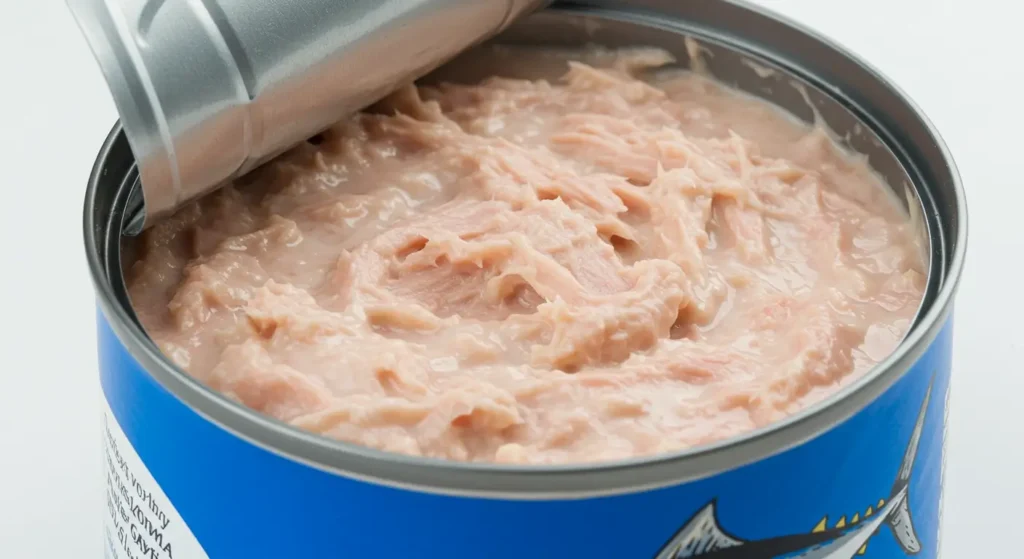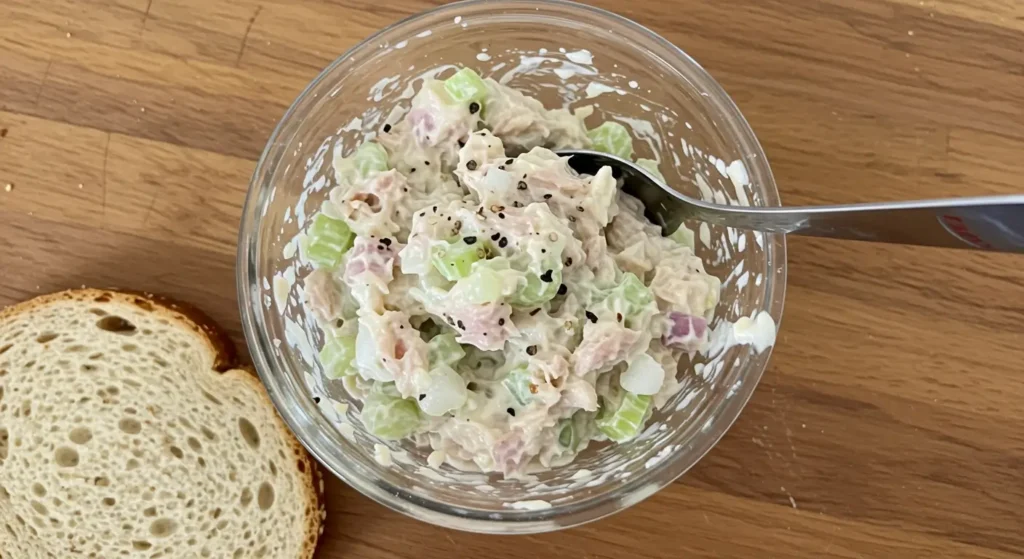How Long Can Tuna Salad Last in the Fridge?
Table of Contents
Knowing How long can tuna salad last in the fridge? Get the answers you need to enjoy your tuna salad longer. is key. The right storage tips prevent bacteria and keep food fresh. This guide covers temperature, containers, and prep steps for freshness. It also teaches how to track expiration dates and avoid waste.
Key Takeaways
- Stored correctly, tuna salad lasts 3-4 days in the fridge.
- Airtight containers slow spoilage and lock in flavor.
- Cold temperatures below 40°F (4°C) extend safety.
- Homemade vs. store-bought tuna-salad has different storage rules.
- Check for slimy texture or strong smells before eating.
Understanding Tuna Salad Shelf Life
The tuna salad shelf life changes based on how you make and store it. Let’s look at what affects its freshness and safety.
Factors Affecting Freshness
Three main things determine how long your tuna salad stays fresh:
- Ingredients: Mayonnaise, dairy, and herbs each have their own expiration dates. Spoiled mayo can shorten the whole salad’s lifespan.
- Hygiene: Unwashed hands or dirty tools introduce bacteria, speeding up spoilage.
- Storage conditions: A fridge set below 40°F slows bacteria growth, while high humidity can accelerate decay.
Impact of Preparation Methods
How you mix your salad matters. Here’s why:
- Prep temperature: Mixing ingredients at room temperature for too long lets bacteria multiply, cutting the tuna salad shelf life.
- Fresh vs. pre-seasoned tuna: Using raw, unseasoned tuna lets you control freshness better than pre-marinated options.
- Tool cleanliness: Sanitized bowls and forks prevent contamination from the start.
By adjusting these steps, you can keep your tuna-salad safe and tasty for longer.
Proper Storage Techniques for Your Tuna Salad
To keep your safe refrigerated tuna salad fresh and safe, follow these steps. Store it within two hours of making to slow down bacterial growth. Keep your refrigerated tuna-salad at 40°F or below to reduce spoilage risk.
- Choose airtight containers. Glass or BPA-free plastic options like Tupperware or GladWare seal in freshness better than open bowls.
- Layer salad in shallow containers (no more than 2 inches deep) for even cooling.
- Label containers with dates using sticky notes or markers to track freshness timelines.
| Container Type | Pros | Cons |
|---|---|---|
| Glass | Non-porous, microwave-safe | Heavier, more fragile |
| BPA-Free Plastic | Lightweight, durable | Requires hand-washing for longevity |
| Stainless Steel | Odor-resistant, reusable | Not microwave-safe |
Always check for condensation inside containers—wipe moisture before sealing to prevent mold. For extra protection, store containers on fridge shelves instead of door racks to avoid temperature fluctuations. Properly stored, your safe refrigerated tuna salad stays fresh up to 3-4 days. Adjust steps based on ingredients; mayo-based salads need colder temps than oil-based versions.

Best Practices for Packaging Tuna Salad
Packaging your tuna salad right keeps it fresh and safe. The right tuna-salad container and sealing methods are key. Follow these steps to keep your meal fresh.
Containers to Use
Choose containers made for food storage. Look for tuna-salad container options like:
- Airtight plastic containers (e.g., Rubbermaid or Tupperware)
- Stainless steel containers for leak-proof storage
- Glass jars with secure lids (e.g., Pyrex)
These materials stop smells from getting in and keep air out, slowing down spoilage.
Sealing and Labeling Tips
Seal containers tightly to keep out contaminants. Use silicone lids or cling wrap over the top before closing. Always label with:
- Date prepared
- Main ingredients (to note allergens)
- Storage instructions like “Refrigerate at ≤40°F”
“Proper labeling reduces the risk of eating expired food by tracking when it was made,” says the USDA’s food safety guidelines.
Keep it in the coldest part of your fridge. Don’t overfill containers to let air in. These steps keep your tuna salad safe and fresh for days.
Safety Guidelines for Storing Your Tuna Salad
Knowing tuna salad spoilage signs is key to avoiding foodborne illness. Always check your dish before eating. Look for these warning signs:
- Unusual Odors: A sour or ammonia-like smell indicates spoilage.
- Texture Changes: Slimy surfaces or crumbling ingredients are red flags.
- Color Alterations: Dark edges or unnatural browning signal decay.

If you spot any of these tuna salad spoilage signs, discard the dish immediately. Spoiled tuna-salad may contain harmful bacteria like Salmonella or Listeria, leading to severe stomach issues. Follow these steps to stay safe:
- Store in a sealed container at ≤40°F (4°C) within 2 hours of preparation.
- Consume within 3–4 days. Check expiration dates on mayo and tuna cans.
- Never taste food to test for spoilage.
Safety first: Discard tuna salad if it shows any spoilage signs. Prioritize freshness by tracking storage time and temperature. Your health depends on spotting these tuna-salad spoilage signs early.
how long can tuna salad last in the fridge
Knowing how long your tuna-salad stays safe to eat depends on two key factors: time and temperature. Follow these guidelines to maximize freshness and safety:
Recommended Storage Times
- Store tuna-salad in the fridge within 2 hours of preparation.
- Consume within 3–4 days for optimal safety and quality.
After this window, bacteria growth accelerates, even in cold environments. Discard any leftovers older than 4 days.
Temperature Considerations
Keep your fridge set to 40°F (4°C) or below. Fluctuating temps (like opening the door frequently) can shorten shelf life. Use a thermometer to verify accuracy.
Pairing proper storage with creative tuna-salad recipes helps use portions before they expire. Try mixing in avocado or swapping mayo for Greek yogurt to refresh the flavor without risking safety. Always store fresh batches separately from older servings to avoid cross-contamination.
Creative Recipes to Extend Your Tuna Salad Enjoyment
Once you’ve mastered tuna-salad storage tips, turn leftovers into fresh dishes that surprise your taste buds. Experiment with flavors while keeping food safety top of mind.
Mix-Ins and Variations
Revamp your tuna-salad with these additions:
- Add diced apples or grapes for a sweet twist, stored airtight per tuna-salad storage tips.
- Mix in roasted red peppers or sun-dried tomatoes for a Mediterranean flair.
- Stir in a spoon of pesto or a dash of hot sauce for bold flavor layers.
Serving Suggestions
Transform tuna-salad into new dishes:
- Stuffed into bell peppers or avocado halves for a colorful appetizer.
- Layered in lettuce wraps with shredded carrots for a light lunch.
- Mixed with pasta for a chilled noodle salad—keep chilled using proper tuna-salad storage tips.

Let creativity guide you while respecting storage rules. Pair bold flavors with smart storage to enjoy tuna salad’s potential without compromise. Your next meal idea could be just a mix-in away!
Recognizing Signs of Spoilage in Fresh Tuna Salad
To keep your tuna salad fresh, it’s important to know when it’s gone bad. Look out for these signs to stay safe:
- Unnatural Smells: A sharp, sour, or fishy smell means it’s spoiled.
- Texture Changes: Sliminess or a gritty feel are signs of bacteria.
- Color Alterations: Gray or yellowish colors mean it’s no longer good.
Remember, tuna-salad has a short shelf life, usually 1–3 days. If you notice any of these signs, throw it away, even if it’s not yet three days old. Always refrigerate it quickly to prevent spoilage.
Listen to your instincts. If it doesn’t look, smell, or feel right, it’s best to avoid it. Regular checks help you stay within the safe time frame and prevent food poisoning.
Conclusion
Keeping tuna salad fresh in the fridge is key. Use airtight containers and keep the fridge cool. This way, your salad stays good for 3-4 days. Always check for signs of spoilage. Bad smells or texture changes mean it’s time to throw it away. This keeps your salad safe and tasty. By following these tips, you can enjoy your tuna-salad for longer. Clean packaging and eating it on time helps a lot. Every bite will be safe and delicious.
FAQ
How long can tuna salad last in the fridge?
Tuna-salad can last 3 to 5 days in the fridge. It’s important to check for spoilage before eating.
What factors influence the shelf life of tuna salad?
Several things affect tuna-salad’s shelf life. Ingredients like mayonnaise and vegetables matter. So does how clean and cold the fridge is.
What are the best storage techniques for my tuna salad?
Store tuna-salad in a cold fridge right after making it. Use airtight containers to keep it fresh.
What types of containers are best for storing tuna salad?
Use airtight plastic or glass containers. Make sure they’re clean and dry to avoid contamination.
How should I seal and label my tuna salad containers?
Seal containers tightly to keep air out. Label them with the prep date to track storage time.
What safety guidelines should I follow when storing tuna salad?
Always check for spoilage signs like bad smells, color changes, or slimy textures. If it looks or smells off, throw it away.
How can I tell when tuna salad has gone bad?
Look for off smells, color changes, or slimy textures. These are signs it’s spoiled.
What are some creative ways to use leftover tuna salad?
Use leftover tuna-salad in sandwiches, wraps, or green salads. You can also mix in new spices or veggies for different tastes.
What are the recommended storage times for tuna salad?
Tuna-salad is best eaten within 3 to 5 days. If stored right, it might last a week. But always check for freshness.

